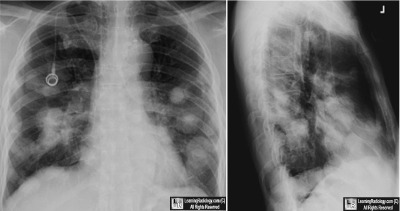| Cardiac | |
|---|---|
| GI | |
| Bone | |
| GU | |
| Neuro | |
| Peds | |
| Faculty | |
| Student | |
| Quizzes | |
| Image DDX | |
| Museum | |
| Mobile | |
| |
Misc |
| Videocasts | |
| Signs | |
Learning
Radiology:
Recognizing
the Basics
Available
on the Kindle
and IPad
LearningRadiology Imaging Signs
on Twitter
![]()
Follow us on
Subscribe to
Our YouTube
Official Channel
Subscribe to Our Instagram Feed
What is the most likely diagnosis?
- 63 year-old male with metastatic disease to the lungs. What is the most likely primary?

Frontal and lateral radiographs of chest
- Glioblastoma Multiforme
- Small Cell Lung Cancer
- Carcinoma of the Prostate
- Carcinoma of the Esophagus
- Pancreatic Adenocarcinoma
Additional Images-Axial CT scan image of chest
![]()
Answer:
4. Carcinoma of the Esophagus
More (Click Discussion Tab)
Cavitary Metastases from Esophageal Carcinoma
General Considerations
- Metastases to the lung occur in about 30% of all malignant disease
- Routes of spread include hematogenous, lymphangitic and direct extension
- Most metastatic lung nodules develop through hematogenous spread
- Primary lung carcinomas cavitate more frequently than metastatic lesions to the lung
- Most cavitary metastases are epithelial in origin
MORE . . .
.
This Week
63 year-old male with metastatic disease to the lungs. What is the most likely primary? |
LearningRadiology
Named Magazine's
"25 Most Influential"

| LearningRadiology.com |
is an award-winning educational website aimed primarily at medical students and radiology residents-in-training, containing lectures, handouts, images, Cases of the Week, archives of cases, quizzes, flashcards of differential diagnoses and “most commons” lists, primarily in the areas of chest, GI, GU cardiac, bone and neuroradiology. |





